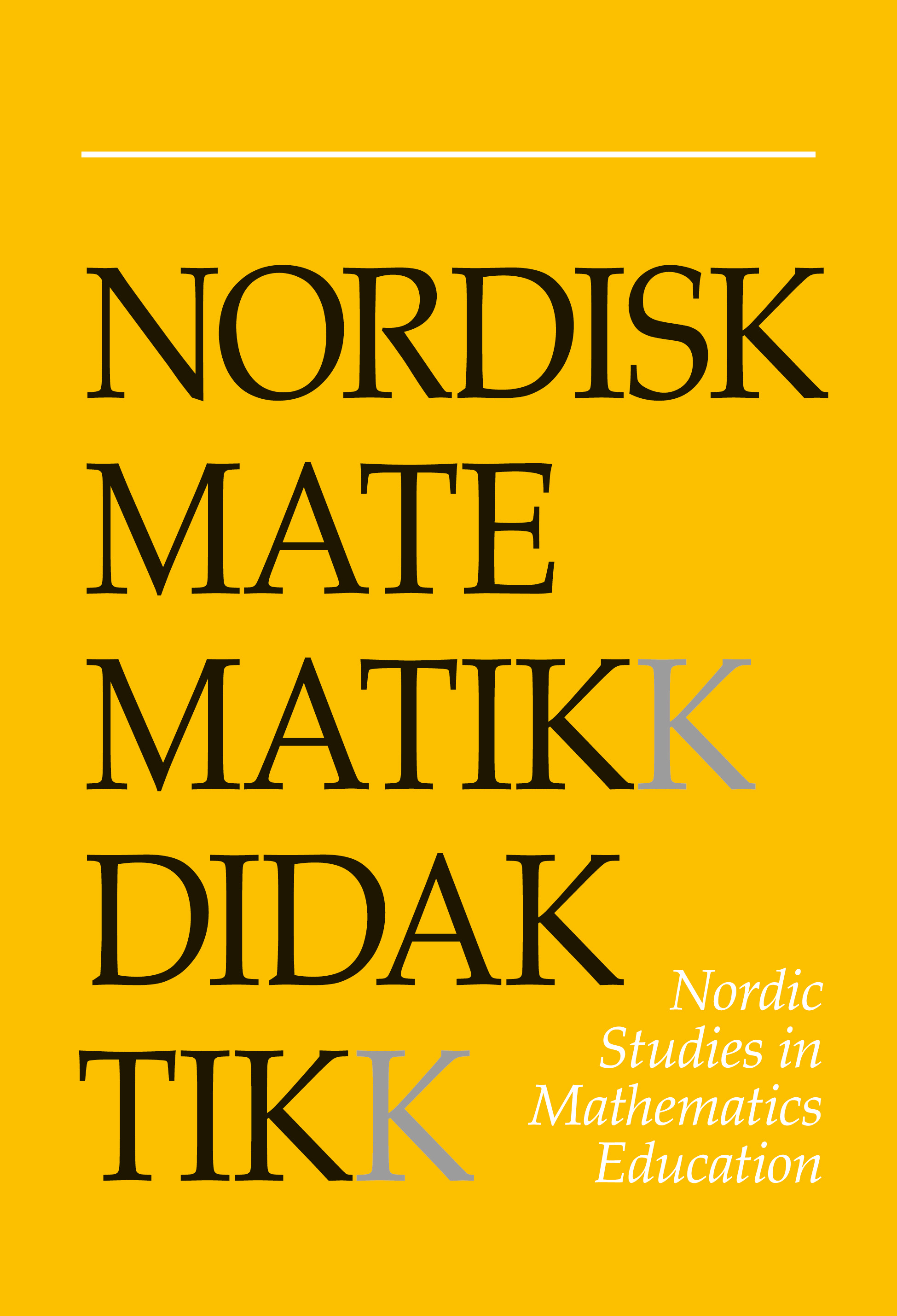Quadratics in Japanese
DOI:
https://doi.org/10.7146/nomad.v9i1.147061Abstract
Starting from a description of two lessons on quadratic equations in a junior high school of Tokyo, this paper attempts to throw new light on the principles and philosophies underlying secondary mathematics teaching in Japan. In particular, the paper concludes by discussing their relation to constructivism and structuralism in the Western sense. To put this description in perspective, some examples of analogous Danish conditions are mentioned.
References
Barthes, R. (1970). L'empire des signes. Genève: Editions d'Art Albert Skira.
Beaton, A., et al. (1996). Mathematics achievement in the middle school years. IEA's third international mathematics and science study. Boston, MA: CSTEEP, Boston College.
Bruner, J. (1966). Toward a theory of instruction. Cambridge, MA: Harvard Univ. Press.
Gandal, M. (1997). What students abroad are expected to know about mathematics. Defining world class standards, vol. 4. Washington, DC: American Federation of Teachers.
Gibson, R. (1984). Structuralism and education. London: Hodder and Stoughton.
Glasersfeld, E. von (1991). Radical constructivism in mathematics education. Dordrecht: Kluwer.
Hessing, S. & Holmer, M. (1992). Faktor 8-9, Begrebsbog (In Danish. English translation of the title: Factor 8-9, Concept book). Copenhagen: Malling Beck.
Hitotsumatsu, S., et al. (2000). Chugakkou Suugaku 3. (In Japanese. English translation of the title: Junior High School Mathematics 3). Tokyo: Gakkou Tosho Publ.
Knoll, S. (1998). Anforderungsgestaltung im Mathematikunterricht. Mathematik lehren 90, 47-51.
Koizumi, S. (2000). Modernization (New Math) and teaching method - example integration methods. Journal of the Study Group on Secondary School Mathematics (special issue for ICME-9), University of Tsukuba, 13-14.
Ma, Liping (1999). Knowing and teaching elementary mathematics. Mahwah NJ: Lawrence Erlbaum. https://doi.org/10.4324/9781410602589
Nagasaki, E., et al. (Eds., 1990). Mathematics program in Japan. Tokyo: Japan Soc. of Math. Ed.
Neubrand, J. (1998). Japanischer Unterricht aus mathematik-didaktischer Sicht. Mathematik lehren 90, 52-55.
Nohda, N., et al. (Eds.) (2000). School Mathematics in Japan. Booklet produced for ICME-9 in Makuhari. Tokyo: Japan Society of Mathematics Education.
Piaget, J. (1968). Le structuralisme. Paris: Presses Universitaires de France. Resnik, M. (1997). Mathematics as a science of patterns. Oxford: Clarendon.
Robitaille, D. and Nicol, C. (1994). Comparative international research in mathematics education. In R. Biehler et al. (Eds.), Didactics of mathematics as a scientific discipline (pp. 403-414). Dordrecht: Kluwer.
Rotman, B. (1988.) Toward a semiotics of mathematics. Semiotica 72, 1-35. Schmidt, W., et al. (1996). Characterizing pedagogical flow. Dordrecht: Kluwer. https://doi.org/10.1515/semi.1988.72.1-2.1
Sekiguchi, Y. (2000). Mathematical proof, argumentation, and classroom communication: a Japanese perspective. In P. Boero et al. (Eds.), Proof and proving in mathematics education. Retrieved from http://www-cabri.imag.fr/ Preuve/ICME9TG12/index.html.
Stevenson, H. & Stigler, J. (1992). The learning gap. Why our schools are falling behind and what we can learn from Japanese and Chinese education. New York, NY: Touchstone.
Stigler, J., et al. (1999). The TIMSS videotape classroom study. Methods and findings from an exploratory research project on eighth-grade mathematics instruction in Germany, Japan, and the United States. U.S. Department of Education.
Undervisningsministeriet (1995). Matematik, Faghæfte 12.
Winsløw, C. (2000a). Between Platonism and constructivism: Is there a mathematics acquisition device? For the learning of mathematics 20 (3), 12-22.
Winsløw, C. (2000b). Transformations in mathematical discourse. In B. Barton (Ed.), Communication and language in mathematics education: The pre-conference publication of Working Group 9 [ICME-9, Tokyo, July 30- August 6, 2000] (pp. 93-102). Auckland: Dept. of Mathematics, University of Auckland.
Downloads
Published
How to Cite
Issue
Section
License

This work is licensed under a Creative Commons Attribution-NonCommercial-ShareAlike 4.0 International License.



